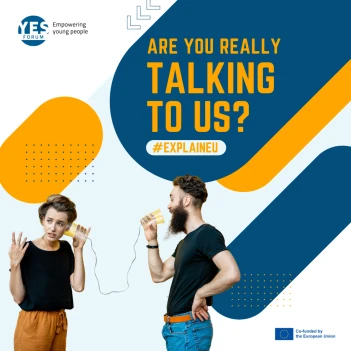European institutions “speak” 24 official languages. However, more than half of young people who responded to the European Parliament’s ‘Youth Survey’ in 2021 said that they “don’t understand much or anything about the EU".
Just the language does not ensure that the European Union and its actions are understandable for young people: EU communication often contains very technical and abstract wording whose meaning is not easy to grasp. The younger generation and the EU do not speak the same language. What if young people, the future of Europe, do not understand what the EU is and does for them?
Young people and the EU share similar concerns. The European Union’s social policies, such as the European Pillar of Social Rights, want to improve the life chances of young Europeans. Tackling poverty and social inequality and combatting unemployment or a lack of jobs are also issues that concern young people, according to the Youth Survey 2021. And, still, youngsters are unaware of what the EU does for them.
So, is the European Union really talking to young people?
EU communication needs to be more inclusive. By helping young people understand what the Union is, and what it stands for, knowledge of their rights and opportunities will grow. More of them will have access to the different European initiatives that aim to enhance their life quality. They will improve their education and skills and thus ensure better employment opportunities.
When young people understand the value of the Union, they will be compelled to contribute to and advocate for a social and fair Europe, one where all voices are heard.
We all work towards an inclusive Europe where young people have the opportunity to thrive, grow and become the person they want. They need to be aware of it: it's time to explain the EU!
Listen to them
What do young people think?
What problems do professionals face when working on EU topics?
Hear from them directly:
Resources to explain the EU
How can communications from the European Union become more inclusive to young people?
Read our recommendations and make use of the easy-to-understand materials:
Policy Paper - Making EU language more accessible for young people
This policy paper aims to address the challenges of applying effective EU communication and raise the awareness of the need to make EU language more accessible and understandable.
Moreover, the document contains recommendations on how EU language can be adapted to respond to its young audience.
Youth-friendly materials on the core EU treaties
The READY project wants to raise EU awareness in young people by making relevant provisions from EU treaties understandable to them. It aims at raising literacy competencies in young people, so they can better understand the meaning of these treaties and the importance that they have over their lives.
EU ready to READ - an easy-to-understand compilation of the most relevant provisions to young people from EU treaties.
EU ready to SEE - infographics on complex EU themes created for young people in collaboration with them and social and youth workers.
Materials are also available in Croatian, French, Greek and Italian here.
Guidelines - Making EU language more accessible for young people
Education institutions and youth and social work organisations have a crucial role to play in supporting young citizens to better understand and connect with the EU.
These set of guidelines are designed to facilitate better and more accessible EU education, through formal and non-formal outlets. They are based on YES Forum’s expertise and experience with young people, through diverse activities and exchange with its member youth and social work organisations.
Join the campaign!
With the #explainEU campaign we aim to raise awareness about inclusive communication in view of the upcoming European elections, among policymakers, European institutions and youth. With your help, we can broaden the reach of this campaign, ensuring that its message resonates across diverse sectors and communities.
How You Can Get Involved:
Spread the word! Share our campaign materials through your communication channels, including newsletters, social media platforms, and any other outlets that reach your network:
- Disseminate the reflections of young people and professionals working with them
- Share the resources on accessible communication
- Or, even easier: share our posts! You can find them by using the #explainEU hashtag or following these links: LinkedIn, Facebook, Instagram

